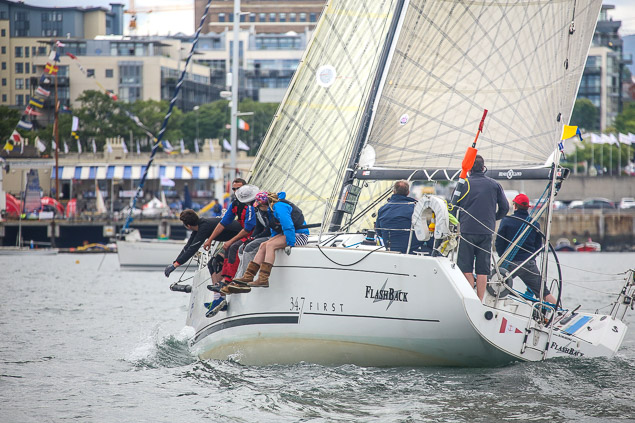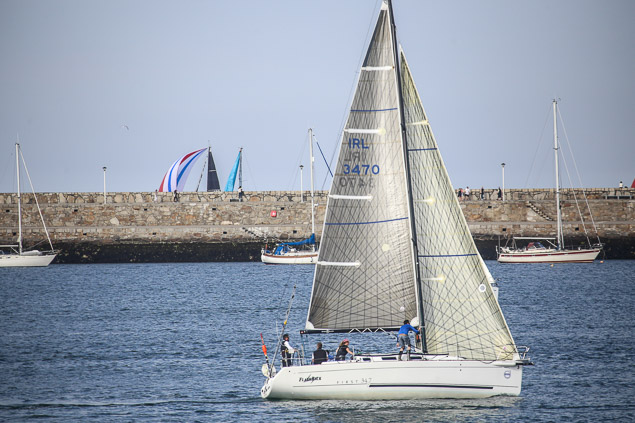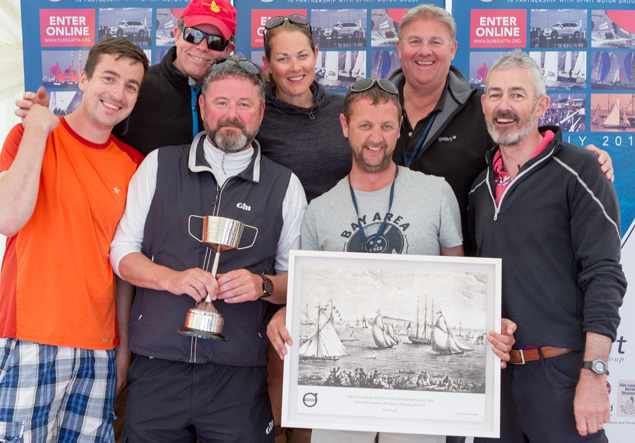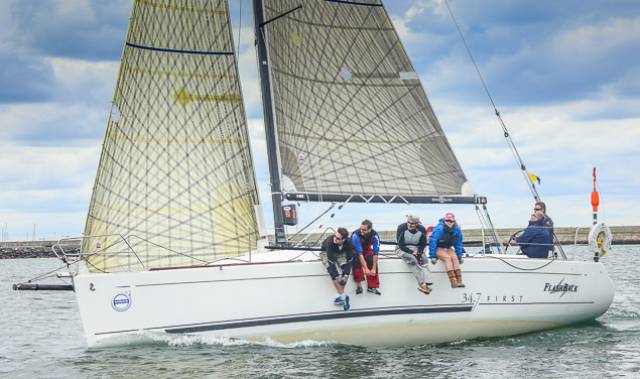Taking on the dominance of the Dun Laoghaire J109 offshore fleet on its home waters and winning is no mean feat. Winning skipper Paddy Gregory of the Beneteau First 34.7 Flashback (owned by Don Breen and David Hogg) recalls last week's victory in Dun Laoghaire Regatta's biggest class, the 31–boat offshore division and believes 'attention to detail' and a strong desire to win got the Howth Yacht Club crew over the line first.
We’ve all heard the term, “That’s Yacht Racing”. It’s a sport where the factors out of your control such as the weather, shifts, Gods, planets, rabbit-feet etc must all align to yield a result. All we can ever do is try and do the best with what we can control and go for it.
If I was to sum up this year’s event in a word I would say, ”tough”.
 Yards from the harbour finish line and overall 2017 VDLR offshore class victory – Flashback's crew give it all they've got. Flashback were also crowned Offshore Champions in the RDYC Jack Ryan Championship as part of VDLR Photo: Afloat.ie
Yards from the harbour finish line and overall 2017 VDLR offshore class victory – Flashback's crew give it all they've got. Flashback were also crowned Offshore Champions in the RDYC Jack Ryan Championship as part of VDLR Photo: Afloat.ie
The usual vagaries of Dublin Bay did not disappoint and dished up the expected amount of tidal and wind challenges; in fairness we did get a little more wind than was forecast.
Although extremely frustrating at times the light airs benefited us against the bigger boats. In the last Dunlaoghaire week it was averaging 20knts and we worked extremely hard to place fourth overall in the Coastal fleet.
Flashback began racing in the ISORA Coastal series a few years ago and we haven’t looked back. The growth in the Coastal Class is a credit to Peter Ryan and his team at ISORA, as it goes from strength to strength, evidenced by it now being the biggest fleet at the VDLR 2017.
 Flashback coming into finish during the first offshore race of Dun Laoghaire Regatta. Photo: Afloat.ie
Flashback coming into finish during the first offshore race of Dun Laoghaire Regatta. Photo: Afloat.ie
Flashback’s a standard Bruce Farr designed Beneteau First 34.7’ (overall length 32.7’!) that we commissioned in 2006 and we were lucky enough to win our first regatta in Dunlaoghaire that season. In the intervening years we’ve changed her very little, so we’re still using a 100m2 asymmetric spinnaker. We resisted the temptation to buy a larger rudder, which many of our sister-ships have done to help with control, choosing instead to learn how to cope with her eccentricities off the wind in a blow…….plus we saved some money!
About four seasons ago, having seen the trend on winning IRC boats, we decided to try non-overlapping headsails, instead of the 142% overlapping genoas that she was designed with, and it’s fair to say that our sailmaker Philip Watson (who we’ve worked very closely with over the twelve years ) really “nailed” it on his second attempt, and we now feel that she’s a faster boat for her rating than she’s ever been (moving from old rating 1003 to 986).
 Flashback's winning crew – Photo: Gareth Craig
Flashback's winning crew – Photo: Gareth Craig
We’ve been fortunate to have continuity of crew (panel of 15) and we now sail both of the Howth Yacht Club Winter series’ which keeps us relatively sharp when the Spring/Summer returns.
We’re very particular about having her underwater surfaces very clean because we don’t want to have that as an “ excuses to lose”. And we’re also picky about excess weight, so we strip off our cruising gear, such as sprayhood and TV, and keep her water & diesel tanks light before racing in events.
As a testament we moved from fourth in the 2015 event to first in 2017. 2015 was a heavy weather event and we all know what 2017 weather was like!
Flashback's crew were:
Paddy Gregory (Helm)
Don Breen Main (Trim)
Saraha Watson (Box)
Eamonn Burke (Kite trim and back up Bow/Mast)
Dave McGinn (Bow/Mast)
Des Flood (Head sail Trim)
Garath May (Head sail Trim)
Tactics (normally by general consensus!)






























































